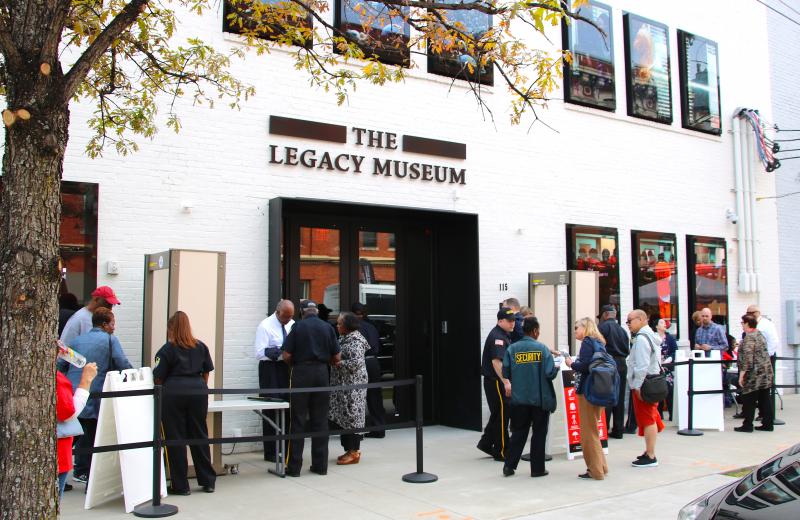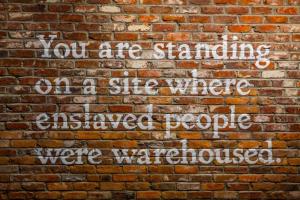The exterior of the Equal Justice Initiative’s Legacy Museum is simple – white paint, black lettering and few photos. That’s where the simplicity ends. The following is a small amount of the information found inside the walls of the recently opened museum.
As visitors make their way down to the main exhibit hall, the first thing they see is a quote from Harriet Tubman saying, “Slavery is next to hell.” The next thing they see are four jail cells with ghostly images of men, women and children telling their stories of being locked up, sold and separated from their families.
Slavery evolved:
Equal Justice Initiative founder Bryan Stevenson, originally of Milton, argues that slavery didn’t end; it evolved into mass incarceration. The main exhibit room of the museum opens with a timeline of that evolution.
- Kidnapped: 12 million people from Africa are kidnapped as part of the Transatlantic slave trade.
- Terrorized: 9 million black people terrorized by the threat of lynching violence.
- Segregation: 10 million African American citizens segregated.
- Incarcerated: 8 million Americans under criminal control.
Reflection room:
The museum has a reflection room lined with the faces of civil rights icons who sacrificed, in some cases even with their lives, for the betterment of people of color. The back wall of the room offers this quote from civil rights activist Mary McLeod Bethune, “If we have the courage and tenacity of our forebears, who stood firmly like a rock against the lash of slavery, we shall find a way to do for our day what they did for theirs.”
Museum by the numbers:
Visitors of the museum are inundated with facts and figures about lynchings and incarceration rates in America. This is a small sample of that information.
- The incarceration rate for women has increased 646 percent in the last 25 years.
- There are 2,400 elected prosecutors in the United States – 95 percent of them are white; 1 percent are women of color.
- The United States has 5 percent of the world’s population, but 25 percent of the world’s prisoners.
- Spending on jails was $6 billion in 1980. In 2017, the amount is $80 billion.
- 70 million Americans have arrest records.
- In 1972, there were 300,000 people in prison. In 2017, that number was 2.3 million people.
- Between 1910 and 1940, nearly 6 million refugees fled north in response to racial terrorism.
- Between 1877 and 1950, there were a total of 4,000 racial terror lynchings in Alabama, Arkansas, Virginia, Georgia, Florida, Kentucky, Louisiana, Mississippi, North Carolina, South Carolina, Tennessee and Texas.
- One documented lynching took place in Delaware – George White, New Castle County, Oct. 6, 1903.
Questions to consider:
As they leave the museum, visitors to the museum are guided past questions EJI would like them to consider. These are the questions.
- Written in 1865, the 13th Amendment to the Constitution reads: Neither slavery nor involuntary servitude, except as a punishment for crime whereof the party shall have been duly convicted, shall exist within the United States, or any place subject to their jurisdiction. EJI asks, should slavery be completely abolished in the United States?
- What does it mean when the Alabama constitution still prohibits racial integration in education and what should be done about it?
- Should the U.S. Supreme Court formally acknowledge its role in authorizing and sustaining the enslavement of black people and apologize for overly racist rulings?
- If you live in a county where a racial terror lynching took place, will you join an effort to memorialize your community’s history?
- Do churches and people of faith have a special obligation to address the history of racial inequity?
- How do we improve police and community relations and end unnecessary police violence?
- Should we find new ways to address student discipline in schools with high suspension and expulsion rates?
- Why would states prohibit interracial romance or marriage?
- Should state governments execute some incarcerated prisoners?
- Today, many schools remain racially separated with little diversity. Why is this and what does it mean?
- Should governments do more to rehabilitate, instead of punish, imprisoned people?
- Should any child be sentenced to die in prison?
- Should we do more to publicly acknowledge our history of racial injustice?
- Most prosecutorial offices don’t have conviction integrity units to help investigate and correct wrongful convictions; should this change?
- How do we eliminate the presumption of guilt assigned to black children?
- What should we do about the growing number of elderly people who are incarcerated?
- Should very young children be prosecuted as adults?
- Most states have done nothing to acknowledge the history of slavery or recognize the legacy of slavery. Why? What should be done about this?
RELATED STORIES:
Bryan Stevenson: Milton native leads fight to challenge past, shape future
National Memorial for Peace and Justice opens in Alabama
Legacy Museum forces a conversation
Chris Flood has been working for the Cape Gazette since early 2014. He currently covers Rehoboth Beach and Henlopen Acres, but has also covered Dewey Beach and the state government. He covers environmental stories, business stories and random stories on subjects he finds interesting, and he also writes a column called Choppin’ Wood that runs every other week. He’s a graduate of the University of Maine and the Landing School of Boat Building & Design.


























































